
Featured research
ES&T | Using Machine Learning to Construct the Blood−Follicle Distribution Models of Various Trace Elements and Explore the Transport-Related Pathways with Multiomics Data.
Follicular fluid is the immediate microenvironment for oocyte growth and development, and various trace elements are directly associated with the development and maturation of oocytes. Due to the presence of the blood-follicle barrier, the transport of substances between the blood and follicular fluid is influenced by selective permeability. Studies have found significant differences in the concentrations of trace elements between follicular fluid and blood. Compared to blood, follicular fluid is a more indicative biological sample of trace element exposure during oocyte growth and development. Analyzing the blood-ovary distribution characteristics of trace elements and their related biological pathways is crucial for assessing exposure risks in the oocyte microenvironment and helps to explore the mechanisms by which trace elements affect oocyte development. In this regard, Researcher Bin Wang from the School of Public Health at Peking University, in collaboration with Peking University People's Hospital, the Reproductive Center of Yantai Yuhuangding Hospital, Fudan University, the Research Center for Eco-Environmental Sciences of the Chinese Academy of Sciences, Kunming University of Science and Technology, the Chinese Research Academy of Environmental Sciences, and Zhejiang University of Technology, conducted a pioneering study. For the first time, they have comprehensively described the blood-ovary distribution characteristics of various trace elements. Through multi-omics analysis, they discovered that the synthesis and signaling pathways of estrogen might be related to the blood-ovary distribution characteristics of these trace elements. Furthermore, they used machine learning models to predict the concentrations of multiple trace elements in follicular fluid, providing a minimally invasive method for exposure assessment.
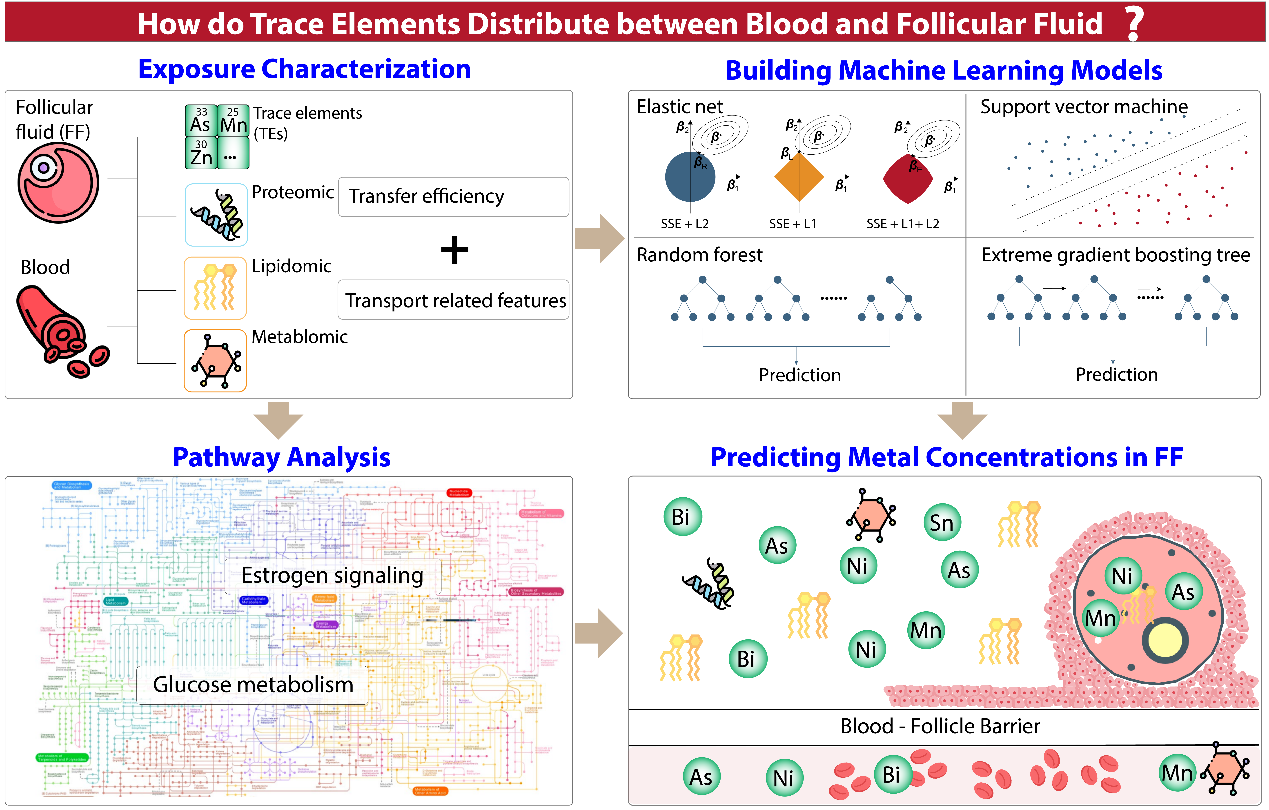
First affiliated institution: Peking University
First author: Guohuan Zhang
Corresponding authors: Bin Wang (Peking University), Lili Zhuang (Qingdao University), Qun Lu (Capital Medical University)
Journal: Environmental Science & Technology, IF2022 = 11.4, CAS 1st Quartile
Article information: Zhang G, Lin W, Gao N, Lan C, Ren M, Yan L, Pan B, Xu J, Han B, Hu L, Chen Y, Wu Y, Zhuang L*, Qun Lu*, Bin Wang*, Fang M. Using Machine Learning to Construct the Blood−Follicle Distribution Models of Various Trace Elements and Explore the Transport-Related Pathways with Multiomics Data. Environmental Science & Technology. 2024, https://doi.org/10.1021/acs.est.3c10904
Main page: https://pubs.acs.org/doi/10.1021/acs.est.3c10904
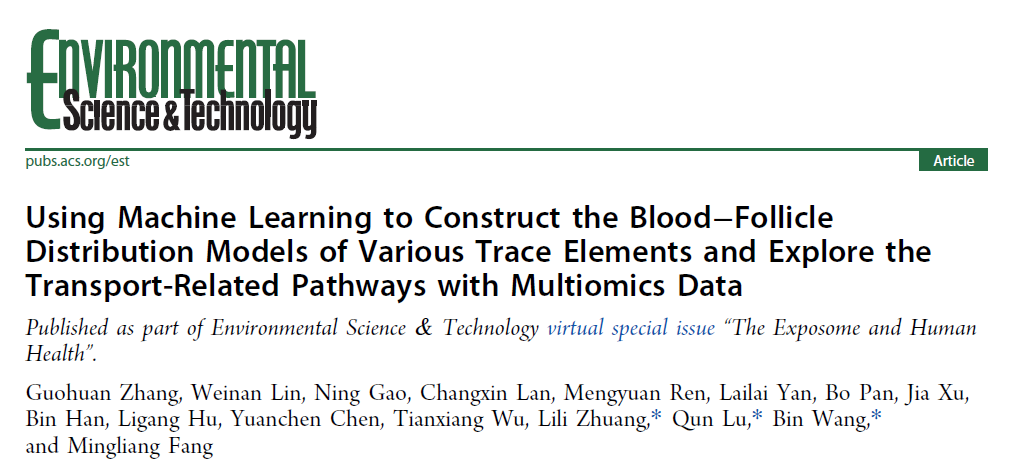
Regarding the blood-ovary distribution characteristics of trace elements and their related biological pathways, Researcher Bin Wang from the School of Public Health at Peking University collaborated with the Reproductive Medicine Center of Peking University People's Hospital and the Reproductive Department of Yantai Yuhuangding Hospital to conduct a study. Through a rigorous cohort study design, a total of 168 women who received assisted reproductive treatment at the two hospitals from 2015 to 2017 were selected. Samples of their serum/plasma and follicular fluid were collected, and 35 trace elements, as well as metabolomics, lipidomics, and proteomics of representative samples, were analyzed. The study found that the blood-ovary distribution characteristics of 21 trace elements were consistent in both Beijing and Yantai hospitals. Among them, five trace elements—arsenic (As), nickel (Ni), manganese (Mn), tin (Sn), and bismuth (Bi)—had significantly higher concentrations in follicular fluid than in serum, indicating enrichment in follicular fluid (Enrichment Group elements). Fifteen elements—antimony (Sb), germanium (Ge), neodymium (Nd), praseodymium (Pr), samarium (Sm), yttrium (Y), mercury (Hg), gadolinium (Gd), cobalt (Co), thorium (Th), lanthanum (La), uranium (U), selenium (Se), titanium (Ti), and iron (Fe)—had significantly lower concentrations in follicular fluid than in serum, suggesting that their transport from blood to follicular fluid might be restricted (Transport-Limited Group elements) (Figure 1A). There was no significant difference in the concentration of cadmium (Cd) between serum and follicular fluid. The transport efficiency (ratio of follicular fluid concentration to serum concentration) of elements in the Enrichment Group and Transport-Limited Group was generally significantly positively correlated within each group, but negatively correlated between the groups (Figure 1B). This suggests the possible existence of a biological pathway simultaneously affecting the enrichment and transport limitation of trace elements, thereby leading to correlated transport efficiency.
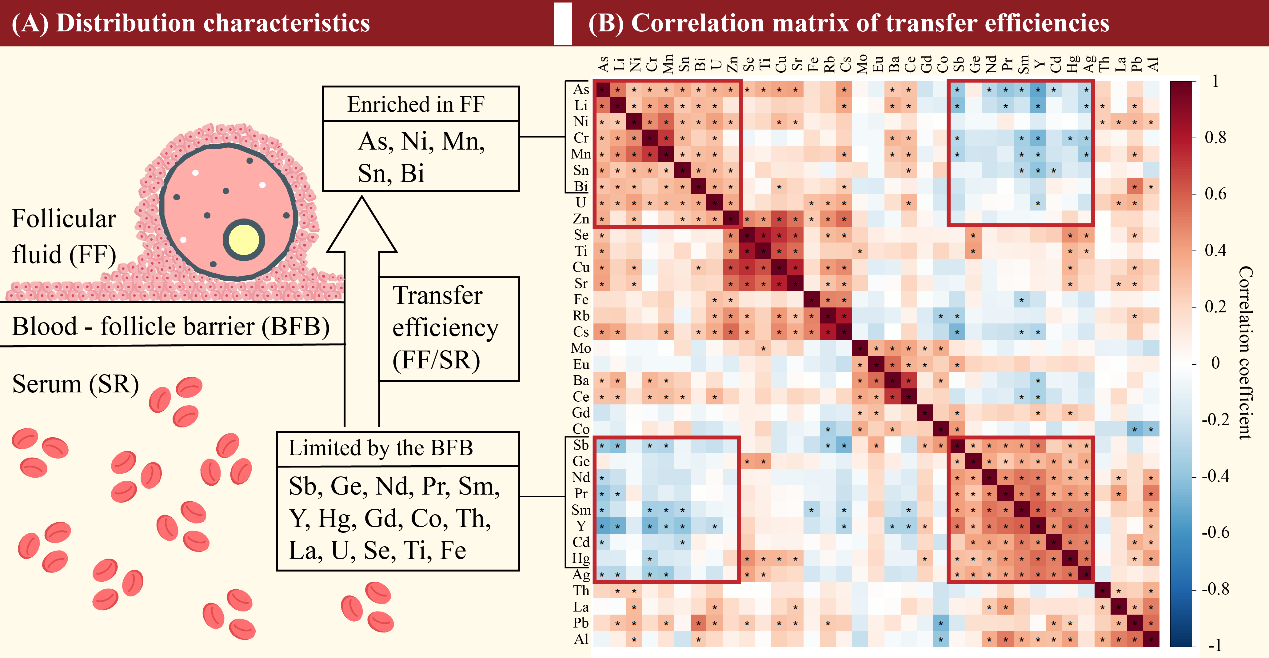
Figure 2. Characteristics of trace element (TE) distribution and transfer efficiencies between the blood–follicle barrier. (A) Distribution characteristics of TEs between the blood–follicle barrier. (B) Correlation matrix of transfer efficiencies, clustered by hierarchical clustering based on the average distance of correlation coefficients.
To explore the biological pathways related to the blood-ovary distribution characteristics of trace elements, the authors integrated metabolomics, proteomics, and lipidomics features with the transport efficiency of trace elements. They used an Elastic Net (ENET) model to identify the biological features associated with the transport efficiency of these trace elements (Figure 3A-B). The selected features were mainly related to the transport efficiency of As, Mn, Sn, and Bi (Figure 3C-D). Subsequently, enrichment analysis and pathway analysis revealed that estrogen signaling pathways and glucose metabolism-related pathways might be associated with the blood-ovary transport efficiency of these elements (Figure 3E).
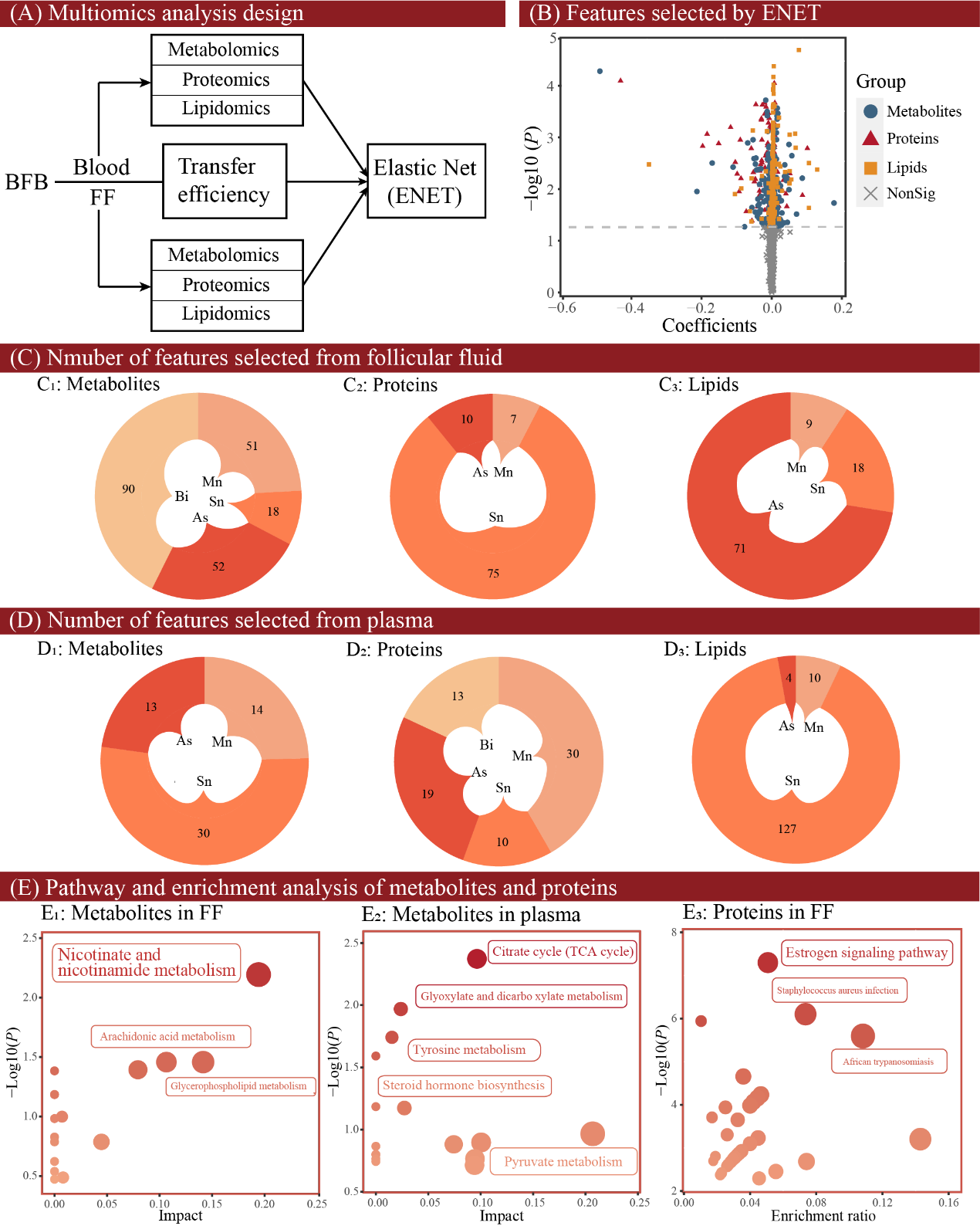
Figure 3. Multi-omics analysis to explore biological pathways related to the blood-ovary distribution characteristics of trace elements. (A) Multi-omics analysis design; (B-D) Multi-omics features related to the transport efficiency of trace elements; (E) Pathway analysis and enrichment analysis of multi-omics features.
To further explore and validate the biological pathways associated with the blood-ovary distribution characteristics of trace elements, the authors integrated various bioinformatics databases, including the Comparative Toxicogenomics Database (CTD), Toxin and Toxin Target Database (T3DB), the Chemical-Protein Interaction Networks (STITCH), and Toxicity ForeCaster (ToxCast), to construct a pathway network diagram related to the blood-ovary transport of trace elements (Figure 4). The results showed that elements in the Enrichment Group were associated with the biosynthesis and signaling pathways of steroid hormones (within the ovary) and oocyte maturation. These elements might share some common transport pathways, including glucose and metal ion transport, ion transport through p-type ATPases, ATPase-coupled inorganic anion/cation transmembrane transport, and the regulation of transmembrane transport of calcium ions, potassium ions, and manganese ions.
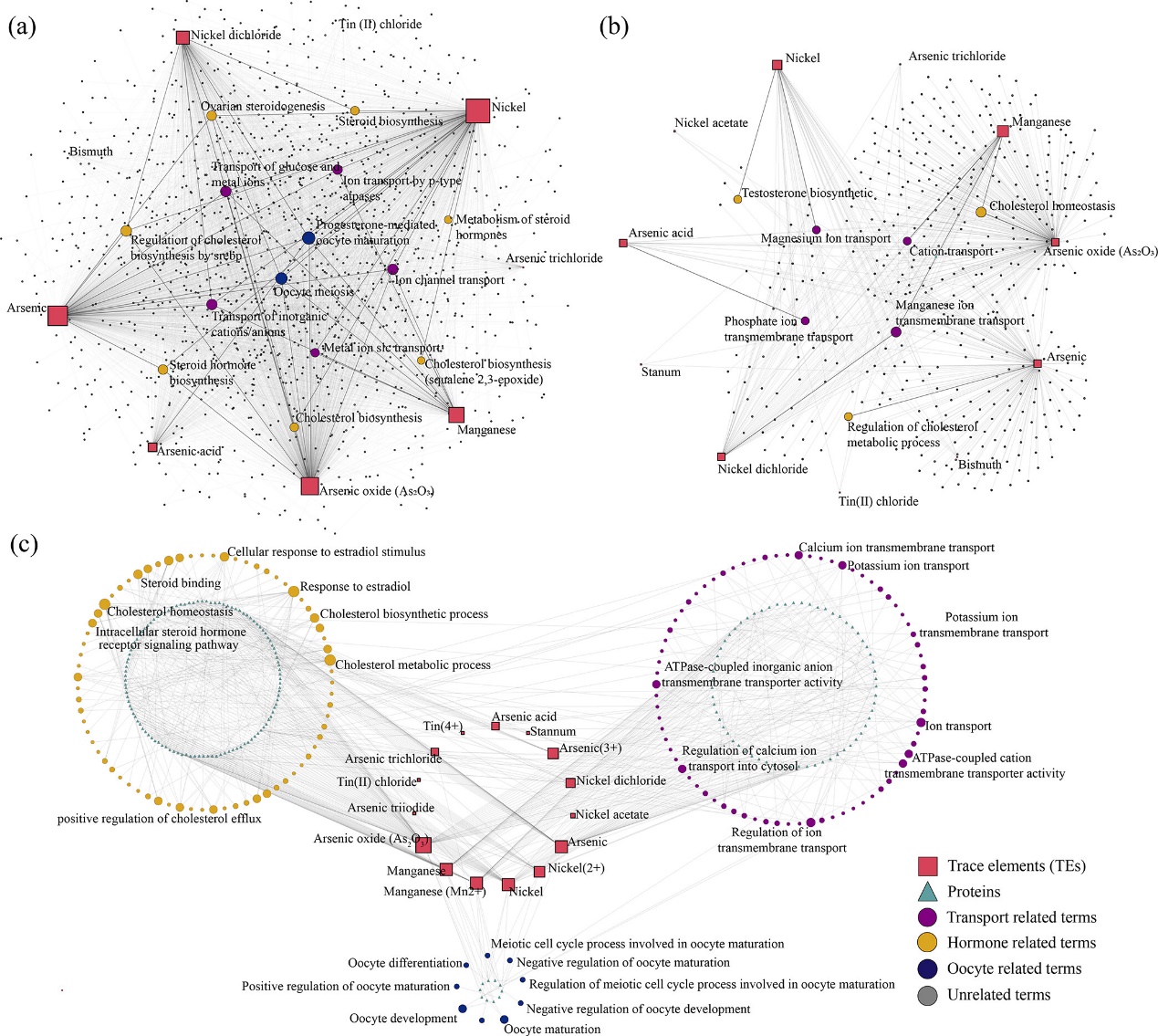
Figure 4. Transport-related pathways of Enrichment Group trace elements. (A) Element-pathway network diagram; (B) Element-Gene Ontology (GO) network diagram; (C) Element-protein-Gene Ontology (GO) network diagram.
Follicular fluid is usually sampled through puncture. To propose a minimally invasive method for evaluating the concentration of trace elements in follicular fluid, the authors used four machine learning algorithms—Elastic Net (ENET), Support Vector Machine (SVM), Random Forest (RF), and Extreme Gradient Boosting Tree (XGBoost)—to establish prediction models for the concentrations of 35 trace elements in follicular fluid. The results indicated that machine learning models could effectively predict the concentrations of some trace elements in follicular fluid, with RF providing the most accurate predictions.
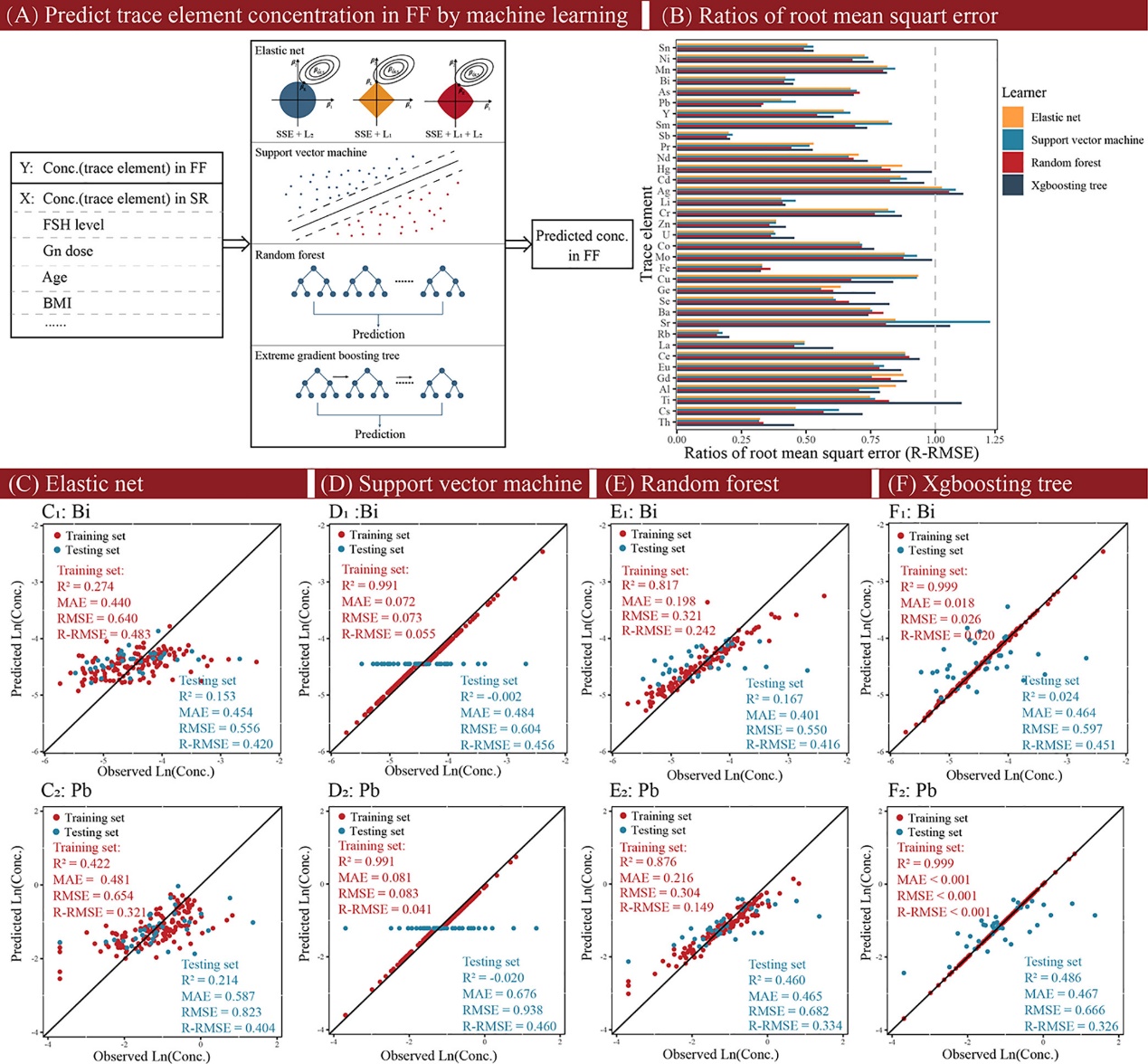
Figure 5. Using machine learning algorithms to establish prediction models for trace element concentrations in follicular fluid. (A) Model establishment scheme; (B-F) Model accuracy evaluation.
This study for the first time comprehensively described the blood-ovary distribution characteristics of various trace elements. Through multi-omics analysis, it was found that estrogen synthesis and signaling pathways might be related to the blood-ovary distribution characteristics of trace elements. Additionally, machine learning models were used to predict the concentrations of various trace elements in follicular fluid, providing a minimally invasive method for exposure assessment. From the perspective of women's reproductive health, these study results can promote the environmental exposure risk assessment of various trace elements.
We thank the China Cohort Consortium (https://chinacohort.bjmu.edu.cn/) and the Key Laboratory of Epidemiology of Major Diseases, Ministry of Education (Peking University) (https://klemd.pku.edu.cn/index.htm) for their collaborative support. We also appreciate the support from the National Natural Science Foundation of China and the National Key R&D Program of the Ministry of Science and Technology of China. Special thanks to the research teams of Ligang Hu (Research Center for Eco-Environmental Sciences, CAS) and Mingliang Fang (Fudan University) for their support in the data analysis and study design.

Guohuan Zhang, received his master's degree from the Institute of Reproductive Health at Peking University School of Public Health. Currently, he is studying at the Sino-Danish College / Research Center for Eco-Environmental Sciences, Chinese Academy of Sciences (CAS). His primary research area focuses on metallomics and its health effects. He specializes in exploring the health effects of metals in various biological samples using multi-omics data, machine learning models, and epidemiological research methods. To date, he has published 2 SCI papers as the first author in journals such as Environment Science & Technology and Environmental Pollution, and co-authored 6 SCI papers. He has participated in 3 projects including those funded by the National Natural Science Foundation of China and the National Key R&D Program of China. He is also a core member of the development team for the ExposomeX platform (http://www.exposomex.cn/).

Bin Wang, Associate Professor/Researcher with tenure at the Institute of Reproductive Health, School of Public Health, Peking University. His main research areas are environmental health, exposomics big data, and artificial intelligence. He employs multidisciplinary research methods to elucidate the impacts and mechanisms of environmental pollution exposure on reproductive health, and to construct health risk assessment models. To date, he has led three projects funded by the National Natural Science Foundation of China (General Program and Youth Fund), and played a key role in three National Key R&D Program projects. He has published 55 papers as the first or corresponding author in international authoritative journals such as Environmental Health Perspectives, Environmental Science & Technology, and The Innovation (H-index = 42, with over 6,500 citations). He serves as a thematic editor for the top journal in the field of environmental health, Environmental Science & Technology, and is involved as an editorial board member for several well-known domestic and international journals (The Innovation, Environment International, Environment & Health, Eco-Environmental Health, China CDC Weekly, and Journal of Environmental Hygiene). He has introduced the undergraduate course "Exposomics," the graduate course "Environmental Exposomics," and the international public health master's course "Environment & Health." He is the leader of the "Environment and Population Health" group of the China Cohort Consortium and the Deputy Secretary-General of the Environmental and Reproductive Health Special Committee of the Environmental Mutagen Society of China. He has received the second prize from the Beijing Preventive Medicine Association for Scientific and Technological Progress and the title of "Outstanding Individual in the National Scientific and Technological System for Fighting COVID-19."

Lili Zhuang, MD, Associate Chief Physician at the Reproductive Medicine Department of Yantai Yuhuangding Hospital. Her main research interests include the diagnosis and treatment of female infertility, reproductive endocrine diseases such as polycystic ovary syndrome, recurrent spontaneous abortion, and individualized ovulation induction therapy. She is proficient in assisted reproductive technologies such as artificial insemination and in vitro fertilization-embryo transfer (IVF-ET, also known as test-tube babies). She has participated in one project each funded by the National Natural Science Foundation of China and the Shandong Provincial Natural Science Foundation. She has published more than 10 papers (6 SCI papers as the first author), authored 2 books, and holds 1 invention patent. She is a member of the Gynecology and Obstetrics Professional Committee of the Shandong Association of Integrative Medicine, the Assisted Reproductive Nutrition Professional Committee of the Shandong Nutrition Society, and the Reproductive Medicine Professional Committee of Yantai. She also serves as a youth editorial board member for the Chinese edition of Human Reproduction Update.

Qun Lu, Professor, Chief Physician, and Doctoral Supervisor at the Reproductive Medicine Center of Beijing Chaoyang Hospital affiliated with Capital Medical University. Her main research direction is reproductive medicine. Her research areas include fertilization mechanisms, oocyte activation studies, oncofertility, the impact of environmental endocrine disruptors on female reproductive function, and optimization of ovulation induction protocols. In recent years, she has published over 50 academic papers as the first author or corresponding author. She has led and participated in several projects funded by the National Natural Science Foundation of China and the Beijing Science and Technology Plan. She serves as the Deputy Director of the Women's Health Capacity Building Professional Committee of the China Maternal and Child Health Association, an expert in medical quality management standardization for the International Organization for Standardization (ISO), and an editorial board member for journals such as the Chinese Journal of Clinical Physicians (Electronic Edition), Chinese Journal of Obstetrics and Gynecology, and Gynecology and Obstetrics Clinical Medicine.
Contributed by | Professor Bin Wang's Team (Peking University)
Reviewed by | ExposomeX Team

